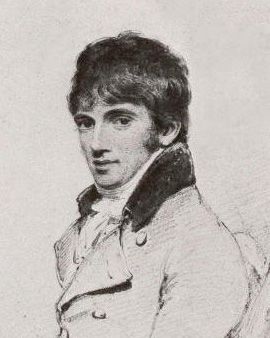William Daniell was an English graphic artist, landscape and marine painter. The young Daniell came to art through an unfortunate stroke of fate, which was to give his life a whole new turn. His father was a bricklayer and his parents owned a small inn. When Daniell was 10 years old, his father died suddenly. Since he was the older son and the mother could not afford to pay for both sons, William Daniell was sent to his uncle Thomas Daniell. Thomas Daniell was a landscape painter, who was especially interested in orientalistic motives. William Daniell was apprenticed to his uncle and at the age of 15 accompanied him on a journey through India for almost 10 years. At the beginning of the journey, the young Daniell was still his uncle's assistant and was mainly responsible for preparing and sketching the motifs. In the course of the journey, however, the balance must have shifted. For on their return to London in 1794, uncle and nephew were partners at eye level.
In London, William Daniell and his uncle worked together to publish some selected paintings from their journey through India. The illustrations were to be printed in aquatint. As a contemporary and friend of Daniell's, the landscape painter Joseph Farington, writes in his diary, William Daniell is said to have worked from 6 a.m. to midnight for 7 years to perfect his technique. Her work "Journey to India" was published in 6 parts and comprised 150 pictures. It became a great success. In spite of all the work William Daniell managed to exhibit a total of 168 paintings at the Royal Academy between 1795 and 1838. In contrast to his uncle, he concentrated less on the landscape, but preferred to paint small scenes with people on the water and other imaginative, oriental motifs.
Daniell was admitted to the Royal Academy School in 1799. He later became an associate and eventually a full member of the Royal Academy. Around 1813 Daniell decided to start a new large travel project, independent of his uncle. It was to be the biggest challenge of his life. Because he planned to paint the landscape, the sights along the coast and the people of the different regions during a journey around the whole coast of Great Britain. Daniell not only wanted to create a work in pictures, but also to provide them with written comments. To this end he entered into a partnership with the writer Richard Ayton, who accompanied him during some parts of the journey. Due to weather conditions, Daniell only travelled in stages of 6 months. Thus the project dragged on for 10 years. During the trip Daniell made the sketches, which he later completed in London in aquatint. Sometimes up to 5 years passed between drawing and printing. This suggests that Daniell had an excellent memory. The work "Voyage Round Great Britain" became his greatest artistic achievement and his most important legacy.
×





.jpg)
.jpg)
.jpg)
.jpg)
.jpg)
.jpg)
.jpg)
.jpg)
.jpg)
.jpg)
.jpg)
.jpg)
_in_Canton_China_Drawn_and_engraved_-_(MeisterDrucke-1503854).jpg)
_in_Canton_China_Drawn_and_engraved_-_(MeisterDrucke-1503854).jpg)
.jpg)
.jpg)
.jpg)
.jpg)
.jpg)
.jpg)
.jpg)
.jpg)
.jpg)
.jpg)
.jpg)
.jpg)
.jpg)
.jpg)
.jpg)
.jpg)
.jpg)
.jpg)
_1832_-_(MeisterDrucke-313062).jpg)
_1832_-_(MeisterDrucke-313062).jpg)
.jpg)
.jpg)
.jpg)
.jpg)
.jpg)
.jpg)
.jpg)
.jpg)
.jpg)
.jpg)
.jpg)
.jpg)
.jpg)
.jpg)
.jpg)
.jpg)
.jpg)
.jpg)
.jpg)
.jpg)
.jpg)
.jpg)
.jpg)
.jpg)
.jpg)
.jpg)
.jpg)
.jpg)
.jpg)
.jpg)
.jpg)
.jpg)
.jpg)
.jpg)
.jpg)
.jpg)
.jpg)
.jpg)
.jpg)
.jpg)
.jpg)
.jpg)
.jpg)
.jpg)
.jpg)
.jpg)
.jpg)
.jpg)
.jpg)
.jpg)
.jpg)
.jpg)
.jpg)
.jpg)
.jpg)
.jpg)
 - (MeisterDrucke-171694).jpg)
 - (MeisterDrucke-171694).jpg)
.jpg)
.jpg)
.jpg)
.jpg)
.jpg)
.jpg)
.jpg)
.jpg)
.jpg)
.jpg)
.jpg)
.jpg)
.jpg)
.jpg)
.jpg)
.jpg)
.jpg)
.jpg)
_1832_-_(MeisterDrucke-274591).jpg)
_1832_-_(MeisterDrucke-274591).jpg)
.jpg)
.jpg)
.jpg)
.jpg)
.jpg)
.jpg)
.jpg)
.jpg)
.jpg)
.jpg)
.jpg)
.jpg)
.jpg)
.jpg)
.jpg)
.jpg)
.jpg)
.jpg)
_seen_of_the_city_of_Port_Louis_from_the_west_of_the_po_-_(MeisterDrucke-1508523).jpg)
_seen_of_the_city_of_Port_Louis_from_the_west_of_the_po_-_(MeisterDrucke-1508523).jpg)
.jpg)
.jpg)
.jpg)
.jpg)
.jpg)
.jpg)
.jpg)
.jpg)
.jpg)
.jpg)
.jpg)
.jpg)
.jpg)
.jpg)
.jpg)
.jpg)
.jpg)
.jpg)
.jpg)
.jpg)
 - (MeisterDrucke-204417).jpg)
 - (MeisterDrucke-204417).jpg)
.jpg)
.jpg)
.jpg)
.jpg)
.jpg)
.jpg)
.jpg)
.jpg)
.jpg)
.jpg)
 - (MeisterDrucke-55992).jpg)
 - (MeisterDrucke-55992).jpg)
.jpg)
.jpg)
.jpg)
.jpg)
.jpg)
.jpg)
.jpg)
.jpg)
.jpg)
.jpg)
_-_(MeisterDrucke-37891).jpg)
_-_(MeisterDrucke-37891).jpg)
.jpg)
.jpg)
.jpg)
.jpg)
.jpg)
.jpg)
.jpg)
.jpg)
 - (MeisterDrucke-598358).jpg)
 - (MeisterDrucke-598358).jpg)
.jpg)
.jpg)
.jpg)
.jpg)
.jpg)
.jpg)
.jpg)
.jpg)
.jpg)
.jpg)
.jpg)
.jpg)






